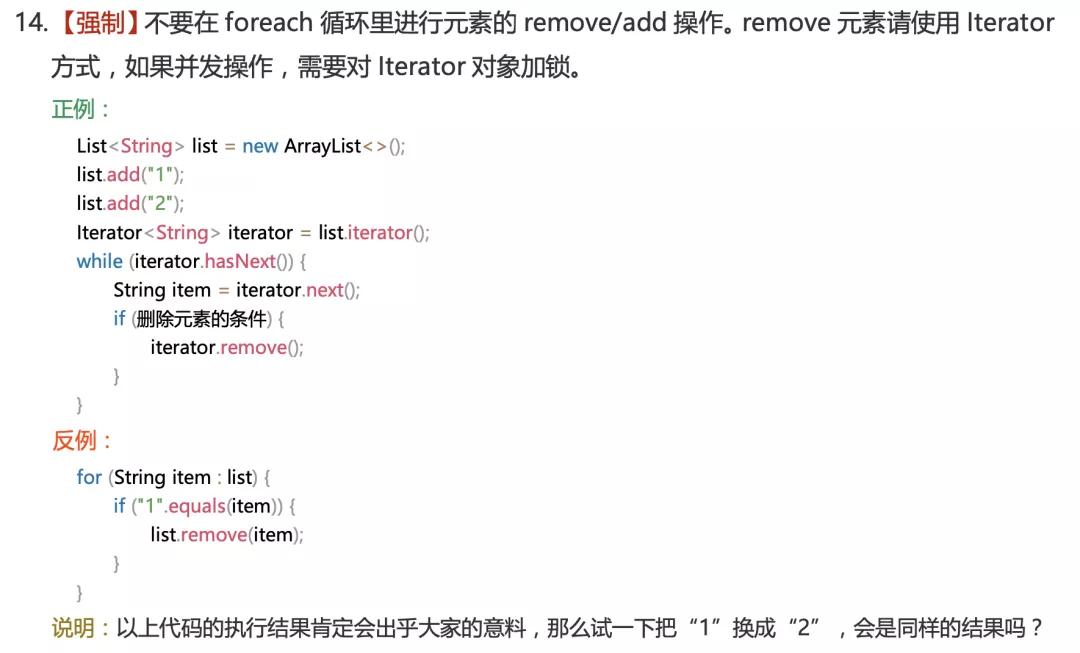为了镇楼,先搬一段英文来解释一下 fail-fast。
In systems design, a fail-fast system is one which immediately reports at its interface any condition that is likely to indicate a failure. Fail-fast systems are usually designed to stop normal operation rather than attempt to continue a possibly flawed process. Such designs often check the system's state at several points in an operation, so any failures can be detected early. The responsibility of a fail-fast module is detecting errors, then letting the next-highest level of the system handle them.
这段话的大致意思就是,fail-fast 是一种通用的系统设计思想,一旦检测到可能会发生错误,就立马抛出异常,程序将不再往下执行。
- public void test(Wanger wanger) {
- if (wanger == null) {
- throw new RuntimeException("wanger 不能为空");
- }
- System.out.println(wanger.toString());
- }
一旦检测到 wanger 为 null,就立马抛出异常,让调用者来决定这种情况下该怎么处理,下一步 wanger.toString() 就不会执行了——避免更严重的错误出现。
很多时候,我们会把 fail-fast 归类为 Java 集合框架的一种错误检测机制,但其实 fail-fast 并不是 Java 集合框架特有的机制。
之所以我们把 fail-fast 放在集合框架篇里介绍,是因为问题比较容易再现。
- List<String> list = new ArrayList<>();
- list.add("沉默王二");
- list.add("沉默王三");
- list.add("一个文章真特么有趣的程序员");
- for (String str : list) {
- if ("沉默王二".equals(str)) {
- list.remove(str);
- }
- }
- System.out.println(list);
这段代码看起来没有任何问题,但运行起来就报错了。
根据错误的堆栈信息,我们可以定位到 ArrayList 的第 901 行代码。
- final void checkForComodification() {
- if (modCount != expectedModCount)
- throw new ConcurrentModificationException();
- }
也就是说,remove 的时候触发执行了 checkForComodification 方法,该方法对 modCount 和 expectedModCount 进行了比较,发现两者不等,就抛出了 ConcurrentModificationException 异常。
为什么会执行 checkForComodification 方法呢?
是因为 for-each 本质上是个语法糖,底层是通过迭代器 Iterator 配合 while 循环实现的,来看一下反编译后的字节码。
- List<String> list = new ArrayList();
- list.add("沉默王二");
- list.add("沉默王三");
- list.add("一个文章真特么有趣的程序员");
- Iterator var2 = list.iterator();
- while(var2.hasNext()) {
- String str = (String)var2.next();
- if ("沉默王二".equals(str)) {
- list.remove(str);
- }
- }
- System.out.println(list);
来看一下 ArrayList 的 iterator 方法吧:
- public Iterator<E> iterator() {
- return new Itr();
- }
内部类 Itr 实现了 Iterator 接口。
- private class Itr implements Iterator<E> {
- int cursor; // index of next element to return
- int lastRet = -1; // index of last element returned; -1 if no such
- int expectedModCount = modCount;
- Itr() {}
- public boolean hasNext() {
- return cursor != size;
- }
- @SuppressWarnings("unchecked")
- public E next() {
- checkForComodification();
- int i = cursor;
- Object[] elementData = ArrayList.this.elementData;
- if (i >= elementData.length)
- throw new ConcurrentModificationException();
- cursor = i + 1;
- return (E) elementData[lastRet = i];
- }
- }
也就是说 new Itr() 的时候 expectedModCount 被赋值为 modCount,而 modCount 是 List 的一个成员变量,表示集合被修改的次数。由于 list 此前执行了 3 次 add 方法。
- add 方法调用 ensureCapacityInternal 方法
- ensureCapacityInternal 方法调用 ensureExplicitCapacity 方法
- ensureExplicitCapacity 方法中会执行 modCount++
所以 modCount 的值在经过三次 add 后为 3,于是 new Itr() 后 expectedModCount 的值也为 3。
执行第一次循环时,发现“沉默王二”等于 str,于是执行 list.remove(str)。
- remove 方法调用 fastRemove 方法
- fastRemove 方法中会执行 modCount++
- private void fastRemove(int index) {
- modCount++;
- int numMoved = size - index - 1;
- if (numMoved > 0)
- System.arraycopy(elementData, index+1, elementData, index,
- numMoved);
- elementData[--size] = null; // clear to let GC do its work
- }
modCount 的值变成了 4。
执行第二次循环时,会执行 Itr 的 next 方法(String str = (String) var3.next();),next 方法就会调用 checkForComodification 方法,此时 expectedModCount 为 3,modCount 为 4,就只好抛出 ConcurrentModificationException 异常了。
那其实在阿里巴巴的 Java 开发手册里也提到了,不要在 for-each 循环里进行元素的 remove/add 操作。remove 元素请使用 Iterator 方式。
那原因其实就是我们上面分析的这些,出于 fail-fast 保护机制。
那该如何正确地删除元素呢?
1)remove 后 break
- List<String> list = new ArrayList<>();
- list.add("沉默王二");
- list.add("沉默王三");
- list.add("一个文章真特么有趣的程序员");
- for (String str : list) {
- if ("沉默王二".equals(str)) {
- list.remove(str);
- break;
- }
- }
break 后循环就不再遍历了,意味着 Iterator 的 next 方法不再执行了,也就意味着 checkForComodification 方法不再执行了,所以异常也就不会抛出了。
但是呢,当 List 中有重复元素要删除的时候,break 就不合适了。
2)for 循环
- List<String> list = new ArrayList<>();
- list.add("沉默王二");
- list.add("沉默王三");
- list.add("一个文章真特么有趣的程序员");
- for (int i = 0, n = list.size(); i < n; i++) {
- String str = list.get(i);
- if ("沉默王二".equals(str)) {
- list.remove(str);
- }
- }
for 循环虽然可以避开 fail-fast 保护机制,也就说 remove 元素后不再抛出异常;但是呢,这段程序在原则上是有问题的。为什么呢?
第一次循环的时候,i 为 0,list.size() 为 3,当执行完 remove 方法后,i 为 1,list.size() 却变成了 2,因为 list 的大小在 remove 后发生了变化,也就意味着“沉默王三”这个元素被跳过了。能明白吗?
remove 之前 list.get(1) 为“沉默王三”;但 remove 之后 list.get(1) 变成了“一个文章真特么有趣的程序员”,而 list.get(0) 变成了“沉默王三”。
3)使用 Iterator
- List<String> list = new ArrayList<>();
- list.add("沉默王二");
- list.add("沉默王三");
- list.add("一个文章真特么有趣的程序员");
- Iterator<String> itr = list.iterator();
- while (itr.hasNext()) {
- String str = itr.next();
- if ("沉默王二".equals(str)) {
- itr.remove();
- }
- }
为什么使用 Iterator 的 remove 方法就可以避开 fail-fast 保护机制呢?看一下 remove 的源码就明白了。
- public void remove() {
- if (lastRet < 0)
- throw new IllegalStateException();
- checkForComodification();
- try {
- ArrayList.this.remove(lastRet);
- cursor = lastRet;
- lastRet = -1;
- expectedModCount = modCount;
- } catch (IndexOutOfBoundsException ex) {
- throw new ConcurrentModificationException();
- }
- }
删除完会执行 expectedModCount = modCount,保证了 expectedModCount 与 modCount 的同步。
简单地总结一下,fail-fast 是一种保护机制,可以通过 for-each 循环删除集合的元素的方式验证这种保护机制。
那也就是说,for-each 本质上是一种语法糖,遍历集合时很方面,但并不适合拿来操作集合中的元素(增删)。
本文转载自微信公众号「沉默王二」,可以通过以下二维码关注。转载本文请联系沉默王二公众号。































